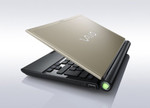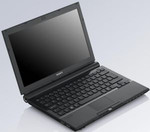Sony Vaio VGN-TZ11XN
Specifications

Price comparison
Average of 7 scores (from 7 reviews)
Reviews for the Sony Vaio VGN-TZ11XN
Source: Reg Hardware
 Archive.org version
Archive.org versionSony has certainly pushed the limits with the TZ11 and the result is generally extreme in every department. Extremely thin, extremely light, extremely long battery life...and an extremely high price tag. The photos of the Vaio VGN-TZ11XN/B show a classic, smart Sony laptop, but they don’t give any sense of just how tiny it is. The TZ11 is 27.7cm wide (that’s under 11 inches) 19.8cm deep (less than eight inches) and it’s 3cm thick at the back of the chassis where the battery clips on. Move to the front and the chassis measures an anorexic 2.55cm thick. The most startling figure from the specification is the 1.19kg weight, which is thanks in part to the small chassis and also to the judicious use of carbon fibre in the base and lid. Add in a mere 400g for the power brick and mains cord and you should have no trouble finding room in your hand luggage for the TX11.
eher kurz gehaltener Test; online abrufbar
75%, Preis/Leistung mangelhaft, Leistung mangelhaft, Mobilität sehr gut
Single Review, online available, Short, Date: 08/08/2007
Rating: Total score: 75% price: 50% performance: 50% mobility: 90%
Source: Pocket Lint
 Archive.org version
Archive.org versionWith the world seemingly obsessed with ever cheaper and cheaper notebooks, it’s great to see that Sony has continued to strive for portable perfection with the release of the VAIO VGN-TZ11XN/B. This machine won’t satisfy the everyman looking for a bargain because at £1799 (inc. VAT) it’s out of most people’s price expectations. However, if you’re looking for something a little different this has to be it. Weighing in at 1.2kg, it’s small and compact enough to slip in your typical briefcase, so you don’t need to be seen to be walking around with a laptop bag, which cuts down on the theft factor. The reason for it’s low weight is the miniaturisation of the motherboard that still allows you to get all the normal features of a computer but in a reduced size. What makes this compact size equally impressive is that you’ll find a DVD rewriter built-in. The 11.1-inch Super-TFT screen also helps.
eher kurz gehaltener Test; online abrufbar
9 von 10, Preis/Leistung schlecht, Leistung mangelhaft, Mobilität gut
Single Review, online available, Short, Date: 07/23/2007
Rating: Total score: 90% price: 40% performance: 50% mobility: 80%
Foreign Reviews
Source: PC Go
 DE→EN Archive.org version
DE→EN Archive.org versionSingle Review, online available, Very Short, Date: 10/03/2007
Rating: Total score: 76% price: 70% display: 90% mobility: 90%
Source: mobile Zeit - 6/07

Single Review, , Length Unknown, Date: 10/02/2007
Rating: Total score: 95% mobility: 95%
Source: Notebookcheck
 DE→EN Archive.org version
DE→EN Archive.org versionSingle Review, , Length Unknown, Date: 08/07/2007
Rating: Total score: 85% performance: 60% display: 93% mobility: 90% workmanship: 82% ergonomy: 85% emissions: 76%
Source: Notebookjournal
 DE→EN Archive.org version
DE→EN Archive.org versionSingle Review, , Length Unknown, Date: 07/04/2007
Rating: Total score: 90% performance: 50% features: 60% display: 100% mobility: 70% workmanship: 90% ergonomy: 70%
Source: PCM
 NL→EN Archive.org version
NL→EN Archive.org versionSingle Review, online available, Short, Date: 07/27/2007
Rating: Total score: 90% performance: 64% display: 80% mobility: 89% workmanship: 80% ergonomy: 70%
Comment
Intel Graphics Media Accelerator (GMA) 950: Intel Graphics Media Accelerator 950 is an integrated (onboard) graphic chip on Mobile Intel 945GM chipset. It is a faster clocked version of the GMA 900 and supports no hardware T&L (Transform & Lightning) accelleration (which is required for some games).
These graphics cards are not suited for Windows 3D games. Office and Internet surfing however is possible.
» Further information can be found in our Comparison of Mobile Graphics Cards and the corresponding Benchmark List.
Intel Core 2 Duo: This is the Core Duo and Core Solo successor with a longer pipeline and 5-20% more speed without more power consumption. As an addition to the Core Duo design there exists a fourth decoder, an amplified SSE-unit and an additional arithmetical logical unit (ALU).
The Core 2 Duo for laptops is identical to the desktop Core 2 Duo processors but the notebook-processors work with lower voltages (0.95 to 1188 Volt) and a lower Frontside bus clock (1066 vs 667 MHz). The performance of equally clocked notebooks is 20-25% lower than Desktop PCs because of the lower Frontside bus clock and the slower hard disks.
U7500: » Further information can be found in our Comparison of Mobile Processsors.
Reviews and price comparison on Sony Laptops at Ciao
Price comparison on Sony Laptops at Idealo






